10 Best Conventional Reels for Bottom Fishing Buying Guide and Review:
Do you want to know which Conventional reel is ideal for Bottom fishing? If that’s the case, this essay is for you. In this blog, Kayak ideas brings you complete info about the 10 Best Conventional Reels for Bottom Fishing 2022 Buying Guide and Review. We’ll also provide you with a quick rundown of each product, including its price, weight capacity, durability rating, and more.
You May Also Like:
What to Wear Kayaking or Canoeing in Summer?
Best Top 5 Safety Whistle For Kayaking in USA – 2022 Update
High-Performance Inflatable Kayaks 2022
A Day Spent With Water Is Never Waste of Time…!
It includes 10 of the most popular reels available today, including spinning and baitcasting models. All of these items are created by respectable firms that have been around for a long time.
Bottom fishing is a fantastic saltwater strategy. Large fish such as halibut, flounder, red snapper, and groupers can be caught. It’s also excellent for catching large freshwater catfish. The key is to get your bait down deep and then have the equipment to bring the fish up. You’ll need the correct tackle for this.
A six- to seven-foot casting rod with strong action and a high-quality conventional reel, in our opinion, is the greatest setup for bottom fishing. You don’t need to be able to cast a mile; all you need is the ability to sense a strike and rapidly apply pressure to the fish.
Conventional reels are often utilized by experienced fishermen or even eager beginners.
The greatest conventional reels are those that are tailored to your unique requirements and are long-lasting, trustworthy, and comfortable to use. Of course, you must purchase reels created by reputed manufacturers if you want a high-quality product.
You’ll also need a reel that makes it simple to begin reeling in the fish so you can move it away from breakable structure. Let’s have a look at some of the most popular bottom fishing reels.
Brand and product quality perceptions frequently have a subjective component. In other words, the phrase “best” is very subjective. Our capacity to assess a reel objectively is influenced by our brand affinity.
While choosing the best surfcasting reel, several factors outside of the brand should be taken into account. I wouldn’t go so far as to say which surfcasting reel is the best in general. To be sure, don’t listen to those who suggest it.
Surfing requires specialised equipment due to its unique requirements. Rods that are 4-5 metres long and sturdy are needed to hold them above the waves and to handle large baits and robust rigging.
They are powerful and have a short casting distance. They’re even better because they’re quite accurate. They do, however, have some disadvantages. While surfcasting, you might expect to come across a bird’s nest now and then. However, the advantages of normal reels outweigh the disadvantages when it comes to surfcasting.
The following step is to match traditional reels. Yes, you are correct; there are many manufacturers, and they are all making reels at breakneck speed.
- 1. Daiwa Saltist
- 2. Kastking Rover
- 3. Penn Squall
- 4. Fin-Nor Lethal Star
- 5. Daiwa Sealine-X SHA
- 6. Daiwa M7HTMAG Cast
- 7. Penn Squall LevelWind
- 8. Kastking ReKon
- 9. Shimano Torium
- 10. Sougayilang Warrior
In a big hurry???
If you don’t have much time, click the links below to quickly search Amazon for the best conventional reels. You can rest confident that we only select the highest quality items and services…
My No. 1
Daiwa Saltist
1. Daiwa Saltist
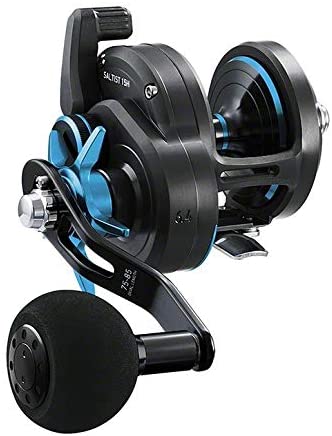
Why is it the Best?
- It’s lightweight.
- Extremely subtle and smooth.
- Sturdy and comfy handle
- Latest Trending Features
- High Performing
- Provides you additional strength while fighting bigger Game
- Gear Ratio is Fast Enough for Jigging
Our Rating: 5/5 Stars
If money is not an issue, the Daiwa Saltist star-drag reel is the way to go.
Consider the Saltist model if you’re seeking for traditional Daiwa reels. This is one of my favourite and most used reels.
It is more expensive than Shimano, but it is well worth it. The sizes range from 15 to 50, with a 6.4:1 gear ratio on all models.
The centrifugal brake is flawless, and the clicking drag is very smooth and consistent. The reel is made of corrosion-resistant materials and can tolerate extreme circumstances. It’s lightweight and well-balanced. It’s something you can do all day and feel comfortable doing.
The entire reel is constructed of anodized metal that has been machined. Nothing on this reel will rust in saltwater, and the aluminium is durable enough to last for years.
Ball and roller bearings are used in the Daiwa Saltist. This is one of the smoothest reels we tested, with the greatest gear ratio. The Saltist allows you to truly dial in the line. This is ideal for jigging or covering a large area of water.
Long casts are simple to make, and backlashes aren’t an issue even when casting into the wind, but you’ll have to get used to it because spells move quickly. For a total newbie, it is not the ideal solution. This reel will cause you a lot of problems if you are still learning how to operate a conventional reel.
Pros
- Extremely quiet and smooth.
- It’s light.
- The handle is large and comfy.
Cons
- The spool is a little too narrow.
- Expensive.
2. Kastking Rover
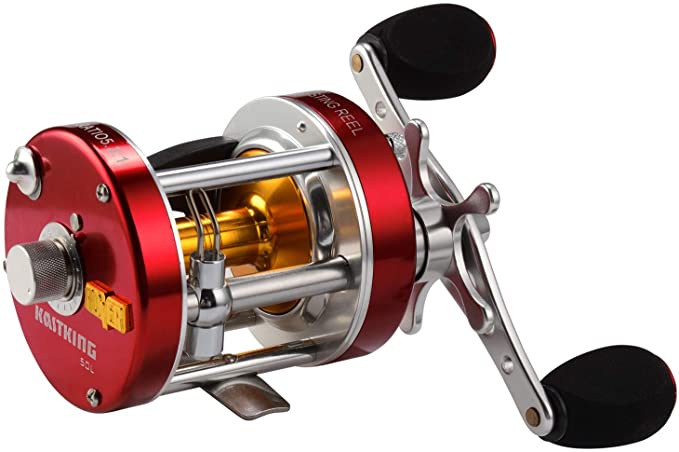
We don’t want to put the KastKing Rover series to the test. The hardness of this reel, on the other hand, is a strong indication of its power. Rover, one of KastKing’s initial products, was recently updated.
The current version, for example, has anodized metal side plates that have been reinforced. Furthermore, instead of the plastic gears used in the original series, the current edition uses brass gears.
Rover is now more durable and long-lasting thanks to these enhancements.
KastKing Left-Rover 50 has a great degree of toughness and is almost bulletproof. This strength is enhanced by the hard-anodized aluminium side plates.
Another significant component of the KastKing Rover 50 is the KastKing Rover 50. The drag system made of carbon fibre contributes to the profile. You can comfortably carry a weight of 30 pounds because to its unique Cymbal Washer System. This feature prevents it from snapping or being damaged while hauling heavy drag. Rover’s flawless running is due to the six+1 double-shielded stainless steel ball bearings.
The ergonomic form of this reel makes it more comfortable and simple to operate. When you’re reeling in a huge fish, the non-slip material on the grip keeps your hands from slipping. Even if you fish for lengthy periods of time, you will not become tired.
It’s not only useful, but it also has a modern look that you’ll love. It fits in any corner of your house and holds a surprising quantity of goods in a little area. The pricing is really attractive, making it very accessible. In this price range, there may be no better option in terms of longevity, compact design, power, and performance. As a consequence, it’s a good long-term investment.
This reel contains several functions that are seen on much more costly reels. It’s a fantastic combination of capability and value. The Rover 60’s side plates and spool are composed of anodized aluminium, while the worm gear shaft is machined brass. Stainless steel is used for the bearings and other interior components. Everything is corrosion-resistant, so you may use this reel in saltwater.
It has an all-metal level wind mechanism that properly distributes line on the spool as you reel. Although you lose some casting range, it is simple to use. In bottom fishing, the shorter casting distance is less essential.
Pros
- • Casting distance is excellent.
- • A fantastic drag mechanism.
- • Can be used in saltwater.
Cons
- • Comparable to other reels of the same type and size, it is very huge.
- • If you apply a lot of pressure to the gears, it might be rather noisy.
3. Penn Squall
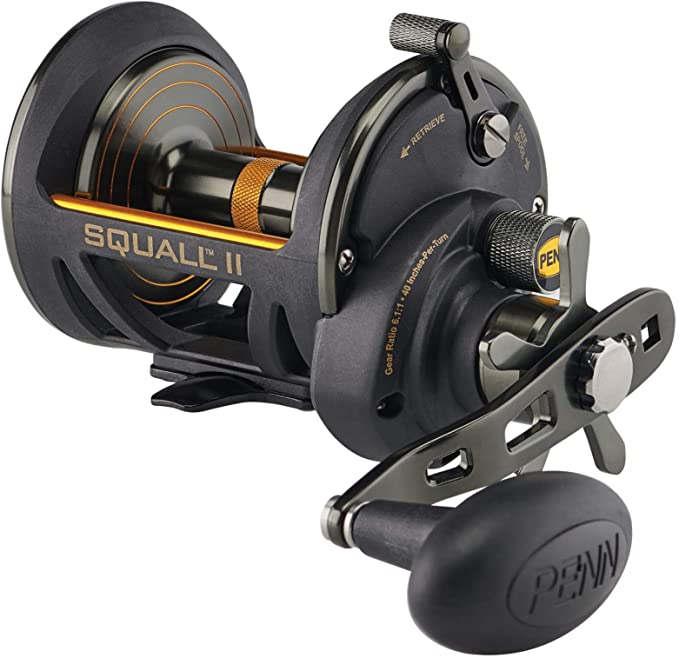
Penn’s Squall Star Drag series comes in five various sizes, each with its unique set of qualities. It weighs 15 to 20 pounds and comes in sizes 12 to 40. The versions 25, 30, and 40 can carry 15 pounds and drag 20 pounds, respectively.
With adjusted-mag braking systems, the sizes 12 and 15 are aimed for the surfcasting business. This allows you to fine-tune the magnetic settings, removing backlashes. This reel is much better for surfcasting because it lacks a level wind mechanism. This technique adds additional friction to your casts, which lowers casting distance and so limits how far you can cast in surfcasting.
The Penn Squall Star Drag is the greatest conventional reel for bottom fishing. It features a 6:1 gear ratio and a line capacity of 240 yards of a seventeen-pound-test monofilament line. It has an easy-to-adjust star drag so you can switch from large throws to battling big fish rapidly. Backlash is no longer an issue with this reel’s magnetic brake.
A graphite frame and side plates, bronze alloy main gear, and stainless steel pinion gear make this a saltwater baitcasting reel. The components are all resistant to corrosion. Precision-machined gears and bearings provide smooth operation and extended life.
On the reel, the Penn Squall has lots of line capacity. It has adequate line capacity to let you to fish deep wrecks and reefs for huge fish. With a rapid anti-reverse engagement, you can determine when a fish is tugging the line with a bait clicker.
Because this reel does not have a level wind, you must keep your thumb on the reel when bringing in line. This also makes it an excellent caster. The Penn Squall Star Drag is a wonderful alternative if you want to utilise the same outfit for bottom fishing and surfcasting.
Pros
- Affordably priced.
- Light in weight
- Drag is forceful and smooth.
- The machine’s structure and bearings are corrosion-resistant.
- Excellent casting skill.
Cons
- It isn’t completely sealed.
- The line capacity shown online differs from that mentioned on the reel, it is, sadly, lower.
- The level wind function appears to be short-lived.
4. Fin-Nor Lethal Star
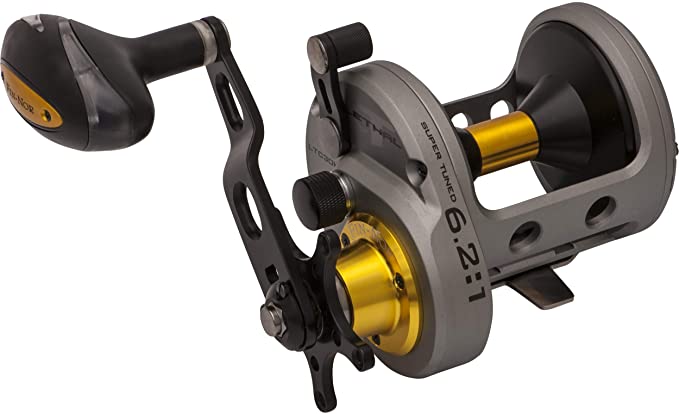
Fin-LTC16 Nor’s star drag reel is the smallest of the company’s three sizes. It, like all previous versions, can handle monofilament and braided fishing lines. It can wrap 350 yards of 20-pound monofilament or 450 yards of 50-pound braid.
The strong all-aluminium frame of the lightweight LETHAL LTC16 helps to keep the weight down. It also has a drag lock-down of up to 25 pounds. Because of its high Drag capacity, the heavy-duty MegaDrag carbon fibre technology creates a great amount of resistance. This capability allows you to winch any type of fish from the ocean floor without a problem.
The X-150’s biggest bearing is 150mm in diameter and provides excellent stability. It includes six stainless steel bearings with two shields that are double-shielded. A one-way roller bearing with a giant lock anti-reverse mechanism is also included.
Bronze and stainless steel gears are also found inside. Both of these materials are corrosion resistant. These qualities make it perfect for usage in seawater. As a result, the LTC16, like the rest of the Lethal series, has a 6.2:1 gear ratio, which translates to 48 inches of line retrieval every handle turn.
With this substantially higher gear ratio, you can easily go for basic bottom fishing, as well as drifting and fishing.
The body, spool, and frame are all made of aluminium. To avoid corrosion, all of the metal is coated. The Fin-Nor Lethal is primarily designed for bottom fishing, but it also has a smooth casting action and great all-around performance. This reel is ideal for a one-rod angler who enjoys the deep water but also surfcasts sometimes.
Fin-Nor, founded in 1933, was one of the first firms to produce deep-sea reels. Since then, deep-sea fishers have trusted these reels. Fin-Nor reels have set almost 900 International Game Fish Association records.
Final Thoughts:
In conclusion, the high gear ratio and recovery pace of this reel allow it to catch large species. However, you should be aware that the parts utilised in this reel are of poor quality. You’ll spend money maintaining it if you wear it out repeatedly due to use and misuse.
Pros
- The aluminium frame is perfect for a low price.
- High-resolution grinding capability.
- Casting reel with more precision.
- 50 pounds is the maximum drag capacity.
Cons
- Using less durable materials
- Hybrid ceramic bearings are more prone to wear and strain.
5. Daiwa Sealine
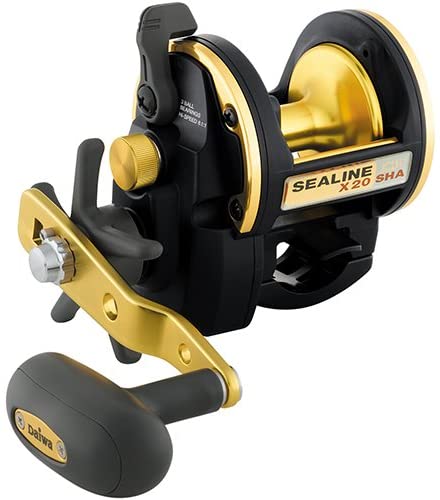
The Daiwa Sealine-X SHA is an excellent choice for heavy shore fishing and boat upside throwing. The X20SHA, X30SHA, X40SHA, and X50SHA are the four versions offered by Daiwa Sealine.
The Endurant XC has three corrosion-resistant ball bearings, a 6.1:1 gear ratio, and a 746cc engine. Other characteristics vary across models.
The 6.1:1 retrieval rate is pretty fast. A huge power handle and CRBB complement this feature, making fishing more comfortable in challenging settings. Overall, the soft-touch grip with the power handle costs nothing but delivers everything when your hand rests on the handle for lengthy periods of time.
Sealine-X SHA is superior in terms of casting. Using a Sealine-X model has several advantages, including improved casting and a smoother feel. When casting with a Daiwa Sealine, a six-element sealed drag will give you more smoothness and consistency.
Nothing, not even the speed shaft technology, which makes you feel like a pro. Furthermore, the free-floating spool separates the spool from the motor system completely, decreasing friction. It has the least amount of friction and has a faster spool speed, enabling longer throws.
Final Thoughts
The Zebco 4070MLD’s diverse performance gives you plenty of alternatives. Using half- or double-ended spools, for example, allows you to customise the running to your liking. Finally, having centrifugal brakes allows you to choose your speed. Furthermore, the use of high-tensile aluminium spools results in a reel that is both durable and light in weight, as well as having a very fast retrieval rate.
Pros
- The frame is built of a lightweight, durable composite.
- High-performance water-resistant drag.
- Quick retrieves and casting are made possible by a high gear ratio.
- Spool made of aluminium with a lot of draw.
- A corrosion-resistant bearing is part of the system.
Cons
- Its plastic structure raises durability issues.
6. Daiwa M7HTMAG Cast
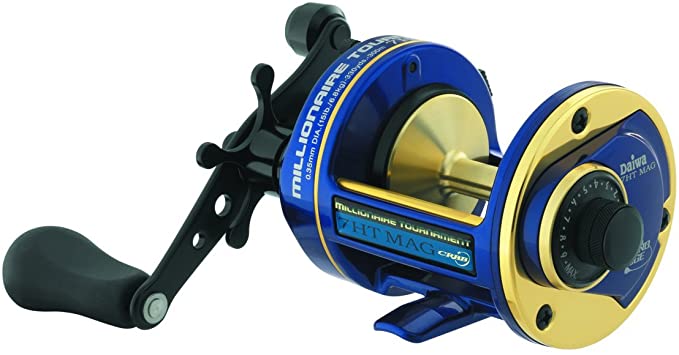
The capacity to endure long is one of the features of the Daiwa M7HTMAG. It features completely adjustable settings, giving the fisherman a sensation of complete control. As a result, fishermen of every ability level may utilise it without difficulty. It can reach a speech of 30,000 RPM when in the cast, making it one of the fastest conventional reels available.
This reel has the Magforce Z technology, which refers to magnetic brakes. These brakes are deployed smoothly and without delays, as the spool reaches maximum velocity, avoiding overruns. Because of the quick spool speed provided by this reel, precise casting is also ensured.
The Mayhem is a shootout machine with seven balls. The bulk of the ball bearings in this loader are induction hardened, although seven are made of high-speed steel (HSS). The HSS balls corrode and wear out over time due to saltwater corrosion on gears and components.
The devil is in the details. The one-piece aluminium frame adds a lot to the experience. M7HT7 weighs 12.2 ounces and, because of its small weight, may be cast for hours without fatigue. Furthermore, with a rapid recovery ratio of 5:8:1, you can quickly recover your line after throwing it thanks to the high gear ratio of 5:8:1.
It is equipped with high-quality brass gear, allowing it to surpass the competition. The stainless steel pinion complements the brass gear.
Final Thoughts
It can handle 330 yards of 15-pound mono and 200 yards of the 20-pound test line.
Due to its exceptional performance and affordability, the Guide 81513F is an excellent all-around fishing reel. However, it has one significant flaw: a weaker drag of 11 pounds. It’s also a good investment because of its longer cast distance and magnetic brakes, which provide accuracy and control.
Pros
- It’s quiet, easy to use, and suitable for anglers of all skill levels, from beginners to experts.
- Magforce Z Technology ensures precision and control.
- It weighs only 12.2 ounces and is exceptionally light.
- Excellent retrieval speed.
- Can go long distances when launched
Cons
- Significantly reduced drag capabilities
7. Penn Squall LevelWind

The Penn Rival level-wind reel is another low-cost option. This reel is comparable in price to the KastKing Rover. The spool will carry 320 yards of 15-pound monofilament. This reel has the most line capacity of the 15-pound reels we tested. The Daiwa Seagate and Fin-Nor Lethal reels carry more lines, but they’re built for bigger fish. It has a level wind attachment with a 5.1:1 gearing.
This reel has a graphite body with an aluminium frame. These materials won’t last as long as some of the other reels on our list, but it’ll still do the job. This is an excellent pick for a casual angler. It does, however, feature the same drag washers as the other Penn reels we’ve talked about.
It’s also the finest reel for freshwater work out of the bunch. Freshwater reels don’t need the more expensive brass, bronze, and stainless steel pieces since freshwater don’t corrode metal as saltwater does.
The Penn Rival is available in both left and right retrieve variants. It also has line capacity rings that indicate how much line is still on the spool. You’ll always know how close you are too striking the end of the reel when a huge fish is stripping the line out.
In the water, the graphite frame is really handy. It’s corrosion-resistant, so it’ll last a long time. Stainless steel ball bearings are also included in the Penn Squall 50 LW. It has high quality and sturdy main gear, an anodized aluminium spool, and machined marine grade bronze components as compared to other parts.
Graphite is a naturally occurring, extremely robust material that will not degrade in seawater. In addition, it is more flexible and durable than other materials. It is also more trustworthy since it includes graphite, which makes it resistant to corrosion in salty environments. It is lighter than many other options available in this market due to its graphite structure.
You should be confident in the ability of such a large trolling reel to level wind. Although the drag strength and retrieval rate aren’t great, they’re acceptable for this type of reel in my view.
It has a high-strength aluminium frame that helps to avoid sagging and strain. The spool is made from the same durable material as the body. Even at speeds of up to 16 miles per hour, this provides for smooth functioning (27 kilometres per hour).
Final Thoughts
Because of its lightweight construction, although having 20 bearings, this reel never feels heavy or cumbersome. The use of HT-100 drag washers also protects the reel from overheating due to its high speed. Its resilience is further demonstrated by its capacity to be used in salt water without fear of wear and damage.
Pros
- Protective coating on ball bearings.
- A fantastic wind system.
- It’s made of corrosion-resistant graphite and is therefore ideal for saltwater fish.
- It’s quite light for a reel of this size.
- The fishing line is quite robust, with a decent line capacity and drag mechanism..
Cons
- It’s challenging for beginners to deal with.
- Graphite is frequently short-lived.
8. Kastking ReKon
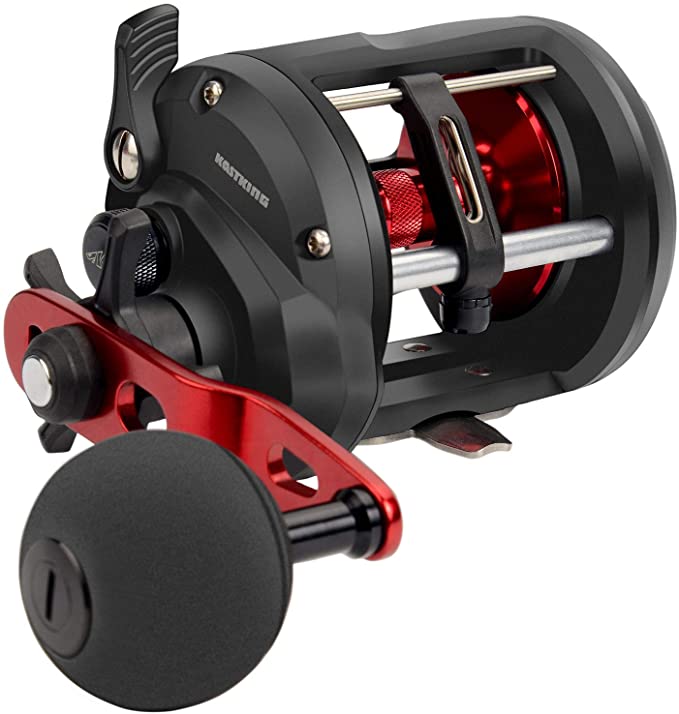
This list includes one more Kastking model. ReKon is a traditional circular reel that performs well while trolling and jigging.
Only 10 and 20 sizes are available.
The elements are well-protected by double shielded ball bearings, while other parts are constructed of durable materials such as stainless steel and brass.
The smaller variant has a 5:1 gear ratio, while the bigger one has a 5.3:1 ratio. Because of its versatility, this medium speed is great for novices.
It’s a 250-yard or 20-pound mono line with plenty of capacity. Carbon disc drag is 30 pounds on bigger discs and 25 pounds on smaller discs. This is plenty of power to capture any fish.
Pros
- On a size 20 reel, the knob is quite big and comfortable.
- Drag is smooth.
- The reel is more powerful than it appears, and it’s a delightful surprise all around.
Cons
- The line counter may skip a few times.
- Loud.
9. Shimano Torium

Shimano is one of the world’s greatest reel manufacturers, so it’s no surprise that one of the reels on this list is from them. Shimano traditional reels, particularly the Torium type, are excellent.
It’s a saltwater reel that’s ideal for bottom fishing or using live bait. Palming the reel is simply because of the clever design. The ridged and robust body of the HAGANE.
This is one of the most costly versions here because of the outstanding quality. It may not be the ideal choice for a total novice, but if you have some expertise and want a high-quality product, this is the one for you.
Pros
- Works great with large, heavy lures.
- Large capacity line.
- Extremely strong, long-lasting, and dependable.
Cons
- The price is exorbitant.
- It’s more for boat fishing than for long-distance throwing (although some anglers use it for surf fishing).
10. Sougayilang Warrior

Finally, I’ll describe Sougayilang’s traditional reels, namely the Warrior type. This is the most affordable model on our list, and it’s ideal for total novices who are still learning.
It comes in three different sizes: 400, 500, and 600. It is highly strong and durable. Although it is saltwater rated, I prefer to use it in freshwater. It’s great for trolling and bottom fishing, but it may also be used for other methods.
Backlashes are not a major issue with the centrifugal braking mechanism. The level wind mechanism works effectively, which is great for beginners because they won’t have to worry about line dispersion throughout the spool.
Pros
- Casting is simple.
- Very inexpensive.
- Line capacity is enough.
Cons
- Although the materials are rust-resistant, I don’t believe it will withstand prolonged exposure to seawater.
- It should be simpler to adjust the drag.
What is Bottom Fishing?
First and foremost, let’s address the obvious question. Bottom fishing is dropping bait or a weighted hook to the bottom of the water column. Isn’t it straightforward? There’s a little more to it, though.
Bottom fishing, as the name implies, is a method of catching fish at the bottom of the water. Some of the largest predatory fish wait for victims at the bottom of the ocean. The bottom is a terrific spot to find huge fish, whether it’s grouper, snapper, and halibut in the ocean or enormous catfish in freshwater.
One of the things that makes bottom fishing so addicting is the fact that there are so many different methods to do it. You may pick from a variety of fishing tactics depending on the water you’re fishing in and what you wish to catch. You may experiment with different bait and equipment, as well as different presentations.
If you capture a large fish, you’ll need enough extra line on the reel to allow the fish to make runs without striking the line’s end.
A hook, bait, and sinker are included in all typical bottom fishing setups. The sinker is necessary since it is what propels the hook and bait to the bottom. When it comes to mounting a weight for bottom fishing, bigger is better. Because their forms don’t catch on structure, egg sinkers and pyramid sinkers are popular for bottom fishing.
Dropper-rigged hooks are used for bottom fishing, with the hook suspended from a short leader slightly above the weight. This allows the bait and hooks to travel with the ocean tide or current.
A reel with lots of lines on the spool is required for bottom fishing. To reach the bottom of deep bodies of water, you’ll need a lot of lines, so be sure you have sufficient on the spool.
What Is a Conventional Reel?
Conventional fishing reels earned their name from the fact that they are the oldest form of reel. (You may see other reel kinds here.) They have a line spool that runs parallel to the rod’s length. These reels are attached to the rod. The distinctions between spinning and conventional reels are obvious. The distinction between baitcasters and traditional reels is less distinct.

They are designed for use in saltwater. The whole design revolves around casting distance. Freshwater is frequently tiny, and fish cling to support. To get the lures in front of the fish, you need to cast them carefully. Distance is everything when casting into the water. Long throws and quick retrieval are the hallmarks of traditional reels.
Conventional reels are composed of high-quality materials as well. Most metals will corrode when exposed to saltwater. Traditional reels are made of stainless steel, brass, bronze, and carbon fibre to withstand the elements.
The majority of the distinctions between these two sorts of reels are internal. The difference is due to geographical differences. Baitcasters are freshwater fishing lures. They’re all about precision, and they provide you with the most control over where your lure falls.
What Makes a Conventional Reel Ideal for Bottom Fishing?
The technique for fishing the bottom is to get the bait down deep and use a reel that makes it easier to reel in the fish. To do so, you’ll need the greatest conventional reel on the market.
Bottom fishing may seem simple, but it presents some unique challenges. It involves long distances, substantial (and invisible) structures, and big fish. Each factor requires unique features in a reel; distance is the easiest factor to visualize. In the ocean, the bottom can be a long way down. You need plenty of line on the spool to carry your hood to the bottom.

Around reefs and wrecks, bottom fishing is popular. There are several things that might grab the line and cause it to break. There’s no way to avoid it since you can’t see it. Fast gearing that can move the fish away from the structure quickly is the greatest technique to keep the fish from breaking the line.
A bait click mechanism is common on traditional reels. When you’re fishing on the ocean floor, there’s no effective way to attach a bobber or strike indication. Instead, the reel is designed such that when the fish bites the bait, it may pull the line off the reel. As this occurs, the reel will click. When you hear those clicks, it’s time to set the hook and reel in the catch.
When picking one of these reels, keep in mind your budget, the type of fishing you’ll be doing, and how often you’ll be using it. Anglers that want to bottom fish in deep water should use a larger reel. A smaller reel, on the other hand, would be ideal for someone who does both surfcasting and bottom fishing. Casual fishermen may prefer a flat wind feature to make things easier, whereas hard-core anglers may prefer longer throws instead.
Finally, bottom fishing frequently yields large fish. Because these fish typically weigh several times the line’s strength, you must let them battle the drag and tyre out. If you hook a fish that can strip line against the drag, you’ll need an additional line on the spool.
FAQs
What’s the Difference Between Spinning and Conventional Reels?
A comparison of conventional and spinning reels will reveal that they are vastly different. I’ve previously discussed traditional reels. The spinning ones are the polar opposite.
Their spools are not rotating and dangle below the rod, with line guides running down the bottom side.
Spinning reels are more user-friendly and suited for beginners. These reels are also superior for smaller fish and lightweight lures. On spinning reels, backlashes aren’t an issue.
Conventional reels often have more line capacity and are lighter than spinning reels of comparable size.
How Do Conventional Reels Work?
I mentioned some of their operating principles in the first chapter, but here are some more information.
The weight of a bait pushes the line out when you cast it. On traditional reels, the spool starts spinning and the friction is low, allowing for long throws.
The spool remains spinning when the bait reaches the water. Because this would result in large tangles and nests, the braking system is employed. It will slow down the spool so that it does not continue to sin for an extended period of time.
Which Brand of Conventional Reels is the Best?
This is a difficult issue to answer because it is dependent on your intended application. However, My Choice is Daiwa Saltist, Penn Squall and Kastking Rover. Not all of them are built in Japan, but the design and quality control are. They are noted for their excellent accuracy, continual improvement, and innovation in the reel production process. Daiwa is my particular favourite of all the reels on this list (and Kastking because of price). Casting distance and remarkable smoothness are its two biggest benefits over Shimano Torium.
What is the Difference Between Conventional Reel vs Baitcaster?
The comparison between a conventional reel and a baitcaster is difficult because both work in the same way.
Although they are commonly used interchangeably, this is not always the case. Some may argue that there is no change at all, which is correct when reel features are considered. Both have spinning spools, are located on top of the reel, have a braking mechanism, and have all of the other features listed above.
Their size is the difference. Traditional reels are larger and more bulky. Experienced fishermen may notice a difference, but beginners will struggle to distinguish between them. Traditional reels are commonly employed for huge fish in difficult situations. In addition, they are slower than baitcasters.
Thank You for sparing your precious time to read this article, please do let us know whatever you feel in the comments section below, and please share this with your fishing buddies.
Have Enjoyable Paddling! 🚣🏻🎣

